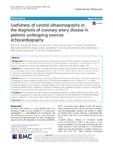Mostrar o rexistro simple do ítem
Usefulness of carotid ultrasonography in the diagnosis of coronary artery disease in patients undergoing exercise echocardiography
| dc.contributor.author | Franco-Gutiérrez, Raúl | |
| dc.contributor.author | Pérez-Pérez, Alberto José | |
| dc.contributor.author | Franco-Gutiérrez, Virginia | |
| dc.contributor.author | Testa-Fernández, Ana María | |
| dc.contributor.author | Vidal-Pérez, Rafael Carlos | |
| dc.contributor.author | López-Reboiro, Manuel Lorenzo | |
| dc.contributor.author | Puebla-Rojo, Víctor Manuel | |
| dc.contributor.author | Santás-Álvarez, Melisa | |
| dc.contributor.author | Crespo-Leiro, María Generosa | |
| dc.contributor.author | González-Juanatey, Carlos | |
| dc.date.accessioned | 2018-10-24T11:03:57Z | |
| dc.date.available | 2018-10-24T11:03:57Z | |
| dc.date.issued | 2018-10-09 | |
| dc.identifier.citation | Franco-Gutiérrez R, Pérez-Pérez AJ, Franco-Gutiérrez V, Testa-Fernández AM, Vidal-Pérez RC, López Reboiro, ML, et al. Usefulness of carotid ultrasonography in the diagnosis of coronary artery disease in patients undergoing exercise echocardiography. Cardiovasc Ultrasound. 2018;16:26 | es_ES |
| dc.identifier.issn | 1476-7120 | |
| dc.identifier.uri | http://hdl.handle.net/2183/21200 | |
| dc.description.abstract | [Abstract] Background. Relationship between carotid and coronary artery disease (CAD) in patients undergoing invasive and non-invasive test is unclear. The aim of the study is to evaluate whether carotid disease is associated with CAD in patients submitted to exercise echocardiography (EE) and if it improves the EE ability to predict CAD. Methods. We retrospectively studied 156 subjects without previous vascular disease who underwent EE, carotid ultrasonography and coronary angiography between 2002 and 2013. Positive EE was defined as exercise induced wall motion abnormalities, carotid disease according to Manheim and American Society of Echocardiography Consensus and significant CAD as stenosis ≥50%. Results. Eighty-nine (57.1%) subjects had significant CAD. Factors associated with CAD in multivariate analysis were fasting plasma glucose (odds ratio [OR] 1.02, p = 0.031), pre-test probability of CAD > 65% (OR 3.71, p < 0.001), positive EE (OR 10.51, p < 0.001) and carotid plaque (CP) presence (OR 2.95, p = 0.013). There was neither statistical significant difference in area under the curve after addition of CP to EE results (0.77 versus 0.81, p = 0.525) nor sensitivity, specificity, predictive values or efficiency. CP presence reclassified as very high-risk according to Systematic COronary Risk Evaluation 13 patients (34.2%) with negative EE and 22 (33.3%) without CAD. Conclusion. CP is associated with CAD in patients undergoing EE, however its addition to EE does not improve CAD prediction, probably due to insufficient statistical power. CP reclassified one third of patients to very high-risk category despite negative EE or CAD absence, these subjects benefit from aggressive primary prevention interventions. | es_ES |
| dc.description.sponsorship | Fundación Ramón Domínguez para la Investigación, el Desarrollo y la Innovación biosanitaria; ECOES | es_ES |
| dc.language.iso | eng | es_ES |
| dc.publisher | BioMed Central | es_ES |
| dc.relation.uri | https://doi.org/10.1186/s12947-018-0143-x | es_ES |
| dc.rights | Atribución 3.0 España | es_ES |
| dc.rights.uri | http://creativecommons.org/licenses/by/3.0/es/ | * |
| dc.subject | Stress echocardiography | es_ES |
| dc.subject | Exercise test | es_ES |
| dc.subject | Carotid artery disease | es_ES |
| dc.subject | Coronary artery disease | es_ES |
| dc.subject | Area under curve | es_ES |
| dc.title | Usefulness of carotid ultrasonography in the diagnosis of coronary artery disease in patients undergoing exercise echocardiography | es_ES |
| dc.type | info:eu-repo/semantics/article | es_ES |
| dc.rights.access | info:eu-repo/semantics/openAccess | es_ES |
| UDC.journalTitle | Cardiovascular Ultrasound | es_ES |
| UDC.volume | 16 | es_ES |
| UDC.issue | 26 | es_ES |
Ficheiros no ítem
Este ítem aparece na(s) seguinte(s) colección(s)
-
INIBIC-ICATC - Artigos [178]






